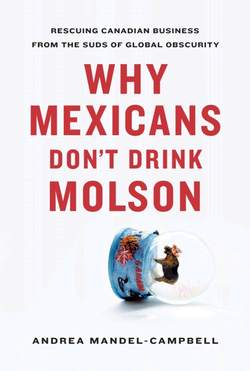Читать книгу Why Mexicans Don't Drink Molson - Andrea Mandel-Campbell - Страница 12
На сайте Литреса книга снята с продажи.
Оглавление3 TARIFFS AND TRAINS: HISTORY ’ S LAST SPIKE
“Canadian businessmen, in their cautiousness, have carried their slowness to decide upon a matter too far for their own good, and have in their desire to be absolutely safe let pass many a good opportunity.”
FRANCIS HECTOR CLERGUE, FOUNDER OF ALGOMA STEEL, 1901
SIR JOHN A. MACDONALD, Canada’s first prime minister, spent much of his long and colourful career haunted by demons, real and perceived. In the mid-1870s, the threat was particularly ominous for the country’s number one nation builder and unabashed power broker. The fledging confederation of thinly populated and disparate territories that Macdonald cobbled together in 1867 seemed in danger of dying on the vine. The world was grappling with the first-ever global depression, as advances in transportation and technology had sent commodity prices tumbling. Trade in Canadian cod and logs had fallen flat while a quarter of the country’s four million inhabitants had headed south to work in the textile mills of New England and the blast furnaces of Pittsburgh.
America’s newfound industrial might and the threat of annexation loomed large over the newly minted country, adding to the dark clouds already swirling over Macdonald’s uncertain political future. Forced to resign in 1873 after being caught offering railroad entrepreneurs lucrative concessions in return for handsome campaign contributions, Macdonald was anxious to rehabilitate his tarnished reputation and reclaim his hold on power. The question was, how?
Cheap, American-made products were flooding the Canadian market, prompting wide-scale layoffs and factory closures. It was becoming increasingly clear that “marauding Americans” and high U.S. tariffs, imposed after the Americans abrogated the reciprocity agreement with the provinces in 1866, were to blame.* Was there not a way to harness the growing disaffection in the streets and its strong anti-American undertones, in such a manner as to rehabilitate Sir John’s sagging fortunes while securing Canada’s fragile nationhood?
In the latter half of the 1870s, the Ontario Manufacturers’ Association,† riding a wave of protectionist sentiment, provided Macdonald with just such an opportunity. The group proposed raising a tariff wall around domestic industry. By keeping foreign manufacturers out, local producers could expand their market with unhampered and mutually beneficial trade within the Dominion. Ontario could ship her breadstuffs to the Maritimes in exchange for Nova Scotia steel, all the while providing desperately needed jobs for the nation. The tariff would not only earn Macdonald the loyalty of the manufacturing interests but, if presented in the proper light, that of the working class as well, while appealing to the nascent tugs of nationhood.
The close alliance forged between Macdonald’s Tories and the Ontario manufacturers struck a highly effective chord, and in 1879 Sir John, successfully reinstalled in the prime minister’s office, unveiled the now-famous National Policy. The plan, which aimed to foster nascent industries through a high protective tariff, evolved into an ambitious blueprint for national development that included the building of a transcontinental railway and the settlement of the West. Each prong of the policy would be to the benefit of the others and would be financed through the revenue-generating tariff.
The natural outgrowth of a colonial mindset that had long been geared to favouring corporate elites and heavy-handed government intervention, the tariff also appealed to an already deeply rooted belief that Canada’s “infant industries” needed to be nurtured if they were to grow and eventually compete in international markets. Before the tariff was erected, Ottawa was flooded with petitions for protection, notes Ben Forster, a Canadian business historian, in his book A Conjunction of Interests: “A bemused Lord Lorne reported to England that ‘everyone who has ever raised a pig or caught a smelt wants protection for his industry.’”62
But what made the National Policy so different and ultimately seared it into the Canadian consciousness was its ability to equate the protection of vested interests with a nationalistic endeavour to protect the Canadian identity. As Sir John ably explained, the country needed to foster industry “to bring out the national mind and the national strength and to form a national character.”63 For a country whose half-hearted move from colony to British dependency had been a dry act of legislative calculation, it was the closest thing to a popular call to arms. “It was a brilliant political play by the manufacturing class,” says Duncan McDowall, professor of Canadian business history at Carleton University. “It combined protectionism, national policy and the identity of the country.”
The emotional link between trade and nationalism would colour Canadian policy decisions for the next century, inextricably melding patriotism and protectionism. The National Policy, under the guise of serving the public good, would encourage the creation of coddled state-sanctioned monopolies while entrenching a clique of well-connected businessmen trained to seek government favour. Perhaps most damaging of all, the high tariff walls and obsession with making “Canadian goods for Canadian people” would blind Canadians to selling to the rest of the world.
Originally presented as a temporary measure aimed at pressuring the Americans into reciprocity, the tariff became indelibly etched into the Canadian business model. Protecting national turf and shutting out foreign competition became part of the “genetic code” of the business community, says McDowall. According to Roger Martin, dean of the Rotman School of Management, “The National Policy was the most damaging thing to happen to Canadian business. There should have been a sunset clause, like parenting.”
